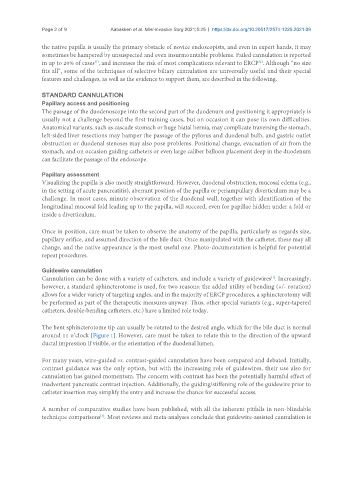Page 243 - Read Online
P. 243
Page 2 of 9 Aabakken et al. Mini-invasive Surg 2021;5:25 https://dx.doi.org/10.20517/2574-1225.2021.09
the native papilla is usually the primary obstacle of novice endoscopists, and even in expert hands, it may
sometimes be hampered by unsuspected and even insurmountable problems. Failed cannulation is reported
[2]
[1]
in up to 20% of cases , and increases the risk of most complications relevant to ERCP . Although “no size
fits all”, some of the techniques of selective biliary cannulation are universally useful and their special
features and challenges, as well as the evidence to support them, are described in the following.
STANDARD CANNULATION
Papillary access and positioning
The passage of the duodenoscope into the second part of the duodenum and positioning it appropriately is
usually not a challenge beyond the first training cases, but on occasion it can pose its own difficulties.
Anatomical variants, such as cascade stomach or huge hiatal hernia, may complicate traversing the stomach,
left-sided liver resections may hamper the passage of the pylorus and duodenal bulb, and gastric outlet
obstruction or duodenal stenoses may also pose problems. Positional change, evacuation of air from the
stomach, and on occasion guiding catheters or even large caliber balloon placement deep in the duodenum
can facilitate the passage of the endoscope.
Papillary assessment
Visualizing the papilla is also mostly straightforward. However, duodenal obstruction, mucosal edema (e.g.,
in the setting of acute pancreatitis), aberrant position of the papilla or periampullary diverticulum may be a
challenge. In most cases, minute observation of the duodenal wall, together with identification of the
longitudinal mucosal fold leading up to the papilla, will succeed, even for papillae hidden under a fold or
inside a diverticulum.
Once in position, care must be taken to observe the anatomy of the papilla, particularly as regards size,
papillary orifice, and assumed direction of the bile duct. Once manipulated with the catheter, these may all
change, and the native appearance is the most useful one. Photo-documentation is helpful for potential
repeat procedures.
Guidewire cannulation
Cannulation can be done with a variety of catheters, and include a variety of guidewires . Increasingly,
[1]
however, a standard sphincterotome is used, for two reasons: the added utility of bending (+/- rotation)
allows for a wider variety of targeting angles, and in the majority of ERCP procedures, a sphincterotomy will
be performed as part of the therapeutic measures anyway. Thus, other special variants (e.g., super-tapered
catheters, double-bending catheters, etc.) have a limited role today.
The bent sphincterotome tip can usually be rotated to the desired angle, which for the bile duct is normal
around 11 o’clock [Figure 1]. However, care must be taken to relate this to the direction of the upward
ductal impression if visible, or the orientation of the duodenal lumen.
For many years, wire-guided vs. contrast-guided cannulation have been compared and debated. Initially,
contrast guidance was the only option, but with the increasing role of guidewires, their use also for
cannulation has gained momentum. The concern with contrast has been the potentially harmful effect of
inadvertent pancreatic contrast injection. Additionally, the guiding/stiffening role of the guidewire prior to
catheter insertion may simplify the entry and increase the chance for successful access.
A number of comparative studies have been published, with all the inherent pitfalls in non-blindable
technique comparisons . Most reviews and meta-analyses conclude that guidewire-assisted cannulation is
[3]

